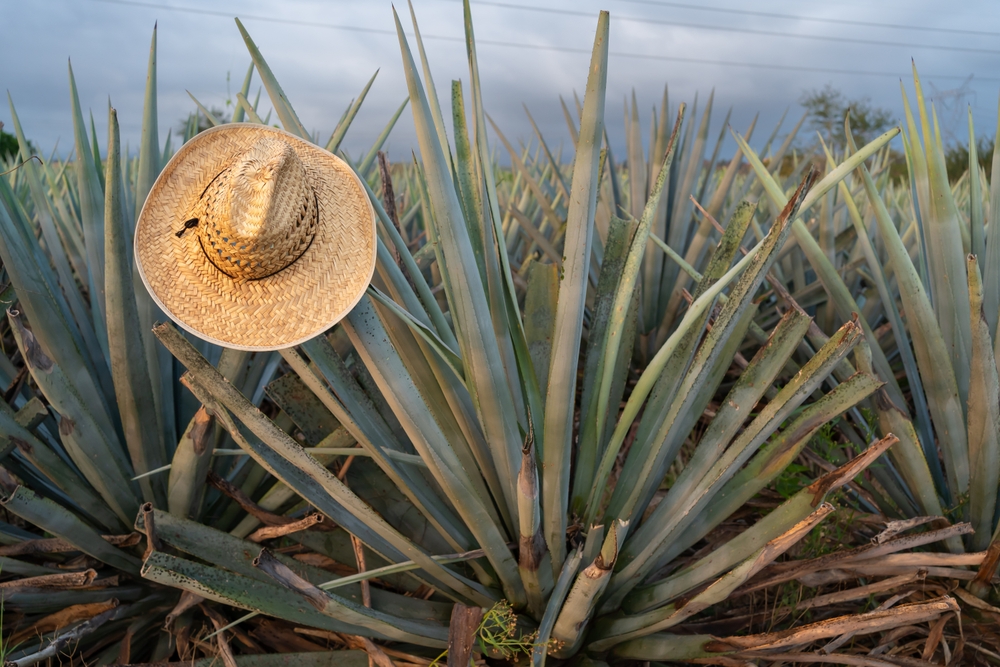Content:
The Blue Agave, scientifically known as Agave Tequilana Weber, is a succulent plant that has been fundamental to the culture and economy of Mexico. From pre-Hispanic times to the present day, Blue Agave has been used in rituals, food, and, more recently, in the production of the iconic Tequila.
In this article, we explore the rich history of Blue Agave, its multiple uses, and some little-known facts that highlight its importance.
Origins and cultivation of Blue Agave
Blue Agave is native to the highlands of western Mexico, especially in the state of Jalisco. The plant adapts perfectly to arid and semi-arid climates, thriving in well-drained soils and surviving conditions where few other plants would. Its adaptability has made Blue Agave an essential crop in the regions where Tequila is produced.
Cultivation and adaptation of Blue Agave
Blue Agave requires approximately 6 to 10 years to mature before it can be harvested. The plant reaches industrial maturity traditionally with its flowering in February and March. Planting takes place before the rainy season so that the offspring can take full advantage of the available moisture.
The harvest is carried out throughout the year. Various tasks are performed between the beginning and end of the production cycle to ensure the plant’s optimal growth and development. Its growth and cultivation process is labor-intensive, involving traditional techniques passed down through generations. The “jimadores” are the experts responsible for harvesting the agave, removing the spiny leaves to expose the “piña,” the part of the plant used to produce Tequila.
Pre-Hispanic uses of Blue Agave
Blue Agave has been used by indigenous cultures in Mexico for millennia, not only for its nutritional properties but also for its ritual value.
Food and medicine
The sweet sap of the agave, known as aguamiel, was fermented to produce pulque, a traditional alcoholic beverage of great importance in ceremonial and everyday life. Additionally, agave leaves and hearts were consumed as food, providing an essential source of nutrients.
In medicine, Blue Agave has various applications. It was used to treat wounds, digestive diseases, and as an antidote for certain poisons. The anti-inflammatory and antibacterial properties of agave made it a valuable tool for indigenous peoples.
Offerings and ritual uses
Blue Agave also played an important role in pre-Hispanic rituals. Archaeological evidence in shaft tombs, especially in the Tequila region, shows that parts of the plant, such as the jimado hearts, were used as funeral offerings. In areas like Sayula and the ancient Teochinchán (now the municipality of Tequila), ovens used to cook agave have been discovered, indicating its ritual and dietary importance.

From Pre-Hispanic offerings to Tequila
Blue Agave not only has a rich history in pre-Hispanic times but has also evolved to become the base of Tequila, the most famous Mexican liquor worldwide.
Tequila Production
Tequila production began during the colonial period with the introduction of distillation techniques by the Spanish. However, it was in the 19th century that Tequila began to gain popularity, especially during the Mexican Revolution, where it became a common drink among the troops.
After the Revolution, Tequila solidified its place in Mexican culture and began to be promoted internationally, partly thanks to its presence in cinema and other media.
Facts about Blue Agave
Biodiversity and sustainability
A little-known aspect is the concern for the biodiversity of Blue Agave. The massive cloning of plants has reduced genetic variability, making the crop more vulnerable to pests and diseases. Researchers from the National Polytechnic Institute of Mexico are working on programs to promote the genetic diversity of Blue Agave, ensuring its long-term sustainability.
Modern innovations
Blue Agave is also used in creating innovative products. The plant’s residues can be transformed into bioplastics and bioethanol, offering sustainable solutions to environmental problems. According to studies by the National Autonomous University of Mexico (UNAM), these bioplastics have properties similar to traditional plastics but with a significantly lower carbon footprint.
Agave in gastronomy
In addition to its use in Tequila production, Blue Agave has found a place in haute cuisine. Agave syrup and nectar are used in various recipes due to their sweet flavor and healthy properties. Agave nectar has a lower glycemic index than conventional sugar, making it a popular choice for people with special diets.
The history of Blue Agave is a testament to its cultural and economic importance in Mexico. From its ancestral uses in rituals and food to its crucial role in Tequila production, Blue Agave has left an indelible mark on Mexican history. Modern advances and sustainable applications of agave ensure that this plant will continue to be vital for future generations.
Thus, Blue Agave is not only an admirable plant for its resilience and versatility but also for its ability to adapt and evolve over the centuries, reflecting the richness and diversity of Mexican culture.


